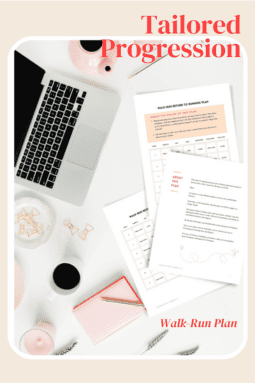Running can throw a few challenges your way, including some of these common running injuries. But, let’s talk about how to navigate these hurdles to keep you sailing through your running journey without getting hurt.
HOW TO SIDE STEP COMMON RUNNING INJURIES
TABLE OF CONTENTS
- Achilles tendonitis
- Runner’s knee (Patellofemoral Pain Syndrome (PFPS)
- Iliotibial band syndrome (IT band syndrome)
- Shin splints
- Plantar fasciitis
- Stress fractures
- Return to running after injury plan
Achilles tendonitis
Achilles tendinopathy is an inflammation of the Achilles tendon, the large tendon that connects the calf muscles to the heel bone and it pops up thanks to the repetitive tension and impact it endures during running.
What are the symptoms of Achilles tendonitis?
- Pain and stiffness: After a run, you might feel a bit of pain and stiffness in the Achilles tendon.
- Swelling: Swelling around the Achilles tendon area may be noticeable, signaling inflammation.
- Tenderness: The affected area might be a little sore to the touch, a gentle reminder that your Achilles tendon needs a bit of attention.
How to treat and prevent Achilles tendinopathy
First, ease into your workout with a warm-up routine.
Then, under the guidance of your physical therapist, add regular strength moves and stretches for your calf muscles and Achilles tendons.
To build up tendon strength, try eccentric heel drops – a controlled lowering of the heel.
In this move, you’ll stand on a step or block with your heels hanging off the edge.
Then, you’ll slowly lower your heels below the level of the step, focusing on elongating your calf muscles.
This move is all about controlled descent, focusing on the lengthening of the muscles. This exercise is fantastic for building strength in your lower legs, especially the calves and Achilles tendon, offering the support and stability you need for your running adventures.
Then, throw in some calf raises to strengthen your calf muscles, which offers additional support to your Achilles tendon.
And here’s the ✨golden rule✨: think slow and gradual when you’re building your mileage and intensity because abrupt spikes in your training can irritate your Achilles tendon.

ProStretch – The Original Calf Stretcher and Foot Rocker for Plantar Fasciitis, Achilles Tendonitis
Runner’s knee (Patellofemoral Pain Syndrome (PFPS)
If you’ve been feeling some discomfort around that kneecap of yours, you might be dealing with the notorious Runner’s Knee, scientifically known as Patellofemoral Pain Syndrome (PFPS). 1
Let’s dive into what could be causing this, and more importantly, how to kick it to the curb.
- Weak quadriceps: Your quads help you stabilize your knee. But, if they’re feeling a bit weak or imbalanced, your kneecap might take more heat during your runs.
- Flatter feet: If your feet are on the flatter side, they might not be giving your knees the support they crave, causing a bit of knee cap discomfort. Time to treat your feet to some new running shoes with the right arch support and say goodbye to any potential discomfort.
How to prevent runner’s knee
Strengthen key muscles: Pay special attention to strengthening these key muscles: quadriceps, hamstrings, glutes, and hip muscles to keep imbalances in check and to say goodbye to runner’s knee.
Do a warmup: Prepping for your run—whether that’s a short, quick one around the block or a race—is all about setting the stage.
Before you hit the pavement, it’s essential to dedicate a few moments to do a warm-up ritual.
Get a gait analysis: Physical therapists aren’t there to patch you up after a running injury; they’re also there to give tips on your gait and injury prevention.
Because physical therapists are experts in movement, look for a physical therapist if you want the most comprehensive gait analysis.
A physical therapist can assess how you walk or run and pinpoint imbalances that might lead to running injuries.
Gradual increase in mileage and intensity: Think slow and gradual when you’re building your mileage and intensity because abrupt spikes in your training can irritate your knees.



RETURN TO RUNNING AFTER AN INJURY PLAN
Dive back into running with this Return to Running After an Injury Plan. Designed for runners like you who have faced setbacks and injuries, this plan offers personalized progression, renewed confidence, injury defense, and instant access to a downloadable PDF to kickstart your journey.
Iliotibial band syndrome (IT band syndrome)
Feeling a twinge of pain on the outside of your knee? Your IT band (iliotibial band) may be to blame.
The IT band is a long, thick band of connective tissue on the outer side of your thigh.
It runs from the hip, along the outside of the thigh, and connects just below the knee. This band helps keep your knee steady while you’re running, but this band can hurt when it gets tight or swollen, causing knee pain.
How to prevent IT band syndrome
Let’s talk about how to make sure this IT band stays happy for a pain-free run.
Strengthen your hips and glutes
Incorporate a variety of exercises targeting the hip and glute muscles into your routine. Moves like step-ups, lateral leg raises, and clamshells can be your IT band’s best friends.
Mind the mileage and speed
When it comes to ramping up your mileage and speed, think of it like cooking a gourmet meal—you can’t rush it. Gradual, steady increments in your running miles and intensity are the way to go. Sudden spikes in distance or pace can put undue stress on your IT band, leading to potential discomfort.
Consider your running form
Your running style might not be IT band’s favorite, but don’t give in to the urge for sudden and major form overhauls.
Abrupt changes could throw off the balance and stress points in your body, opening the door to potential new injuries. So, what’s the game plan?
Gradual improvements are the key, like incorporating drills such as high knees and skips into your routine.
Plus, getting a pro’s advice, like a skilled physical therapist, for a detailed look at your gait, is a smart move.
They can offer insights tailored to your unique running mechanics, helping you tweak without jeopardizing stability and inviting new issues.
Shin splints
Shin splints, also known as medial tibial stress syndrome, refer to pain along the shinbone (tibia), the large front bone in your lower leg.
Symptoms of shin splints include tenderness along the inner side of your shin, especially after some intense activity.
Why do you get shin splints?
This pain often appears when you’ve been pushing too hard or making sudden changes in your running routine.
How do you recover quickly from shin splints?
Here’s a recovery roadmap to guide you: 2
- Rest: Take a breather from running or any activity triggering those shin splints. Typically, the discomfort subsides as your legs enjoy the rest they need, usually within three to four weeks.
- Ice therapy: Treat your shins to 15-20 minutes of ice several times a day to dial down inflammation and ease the ache.
- Pain meds: Over-the-counter NSAIDs can be your temporary allies, but watch out for unwanted side effects such as heartburn, stomach pain, headaches, dizziness, or high blood pressure.
- Physical therapy: Team up with a physical therapist to build leg strength and refine your form, preventing shin splints from crashing your running party.
Plantar fasciitis
Let’s chat about plantar fasciitis – a common running injury.
When the plantar fascia, a sturdy band in your foot acts up, you might feel a sharp stabbing pain in your heel, especially when you take that first step out of bed in the morning; that’s plantar fasciitis and it can throw a wrench into your running plans.
Why does plantar fasciitis happen?
- Overtraining: Doing too much too soon—mileage, hills, or speed—can put some strain on your plantar fascia.
- Tight calf muscles: When your calf muscles are too tight, it can lead to irritation.
- Old shoes: Wearing worn-out running shoes or switching between high heels and flats can irritate your plantar fascia.
- Foot mechanics: Sometimes, your foot’s natural structure, whether it’s high arches or flat feet, can alter your mechanics and play a role in developing plantar fasciitis.
How to recover from plantar fasciitis
- Rest: Give your feet a break – rest and ease up on high-impact activities.
- Ice: Ice those sore spots for 15-20 minutes a few times a day to calm down the inflammation.
- Stretch: Gently stretch your calf muscles and the plantar fascia to release tension.
- Shoe upgrade: Invest in comfy running shoes that fit and support your feet.
- Extra support: Consider using inserts to give your arches an extra lift.
- Physical therapy: Team up with a physical therapist for exercises to strengthen your foot and leg muscles.
- Gradual return: Once your pain has subsided, reintroduce running gradually and keep an eye out for any discomfort.
If your pain sticks around, it’s a good idea to talk to a healthcare provider for some personalized advice.
Stress fractures
Stress fractures, those tiny hairline cracks in your bones, often appear when you’ve been unwaveringly committed to your running routine without giving yourself the necessary breaks.
The first signal of a stress fracture usually comes in the form of localized pain, especially before or during your run.
Watch for these telltale signs of a stress fracture:
- Swelling around the affected area.
- Sensitivity near the impacted bone.
- Bruising in the injured spot.
- Pain that gets worse during activities with impact but eases with rest.
- Adjusting your running style to minimize pain.
How to recover from a stress fracture
Healing from a stress fracture involves teaming up with your doc and confirming the situation through an x-ray.
It’s crucial to stick to your doctor’s advice on rest and recovery – skipping it could turn a minor hiccup into a full-blown fracture.
Getting back on your feet post-stress fracture requires a combo of time and patience.
Once you get the green light to hit the pavement again, think about easing into it with a gradual return-to-running plan to give your body a gentle reintroduction to running.



RETURN TO RUNNING AFTER AN INJURY PLAN
Dive back into running with this Return to Running After an Injury Plan. Designed for runners like you who have faced setbacks and injuries, this plan offers personalized progression, renewed confidence, injury defense, and instant access to a downloadable PDF to kickstart your journey.

